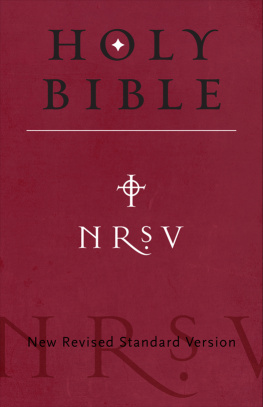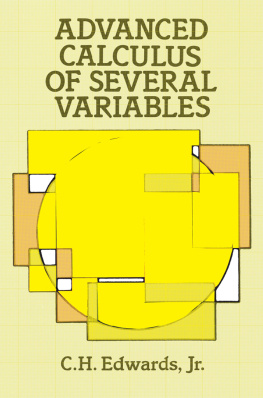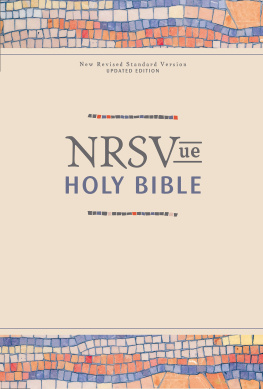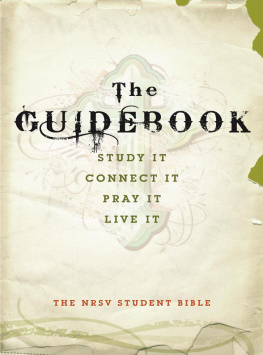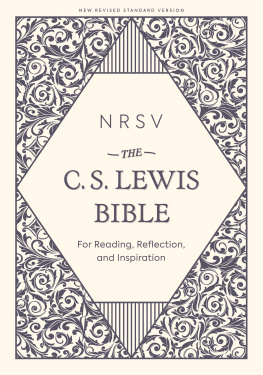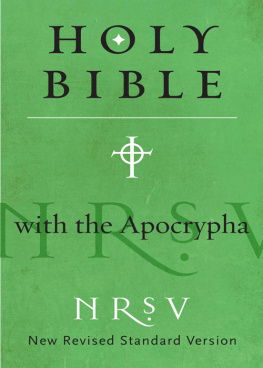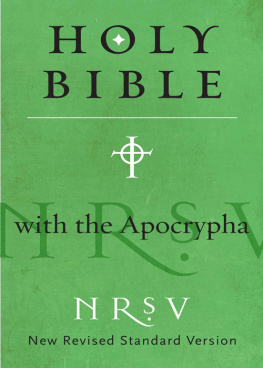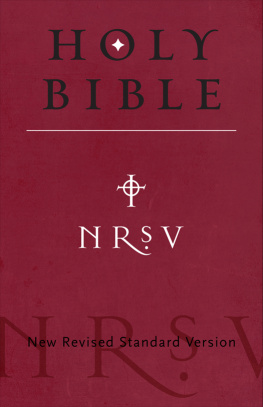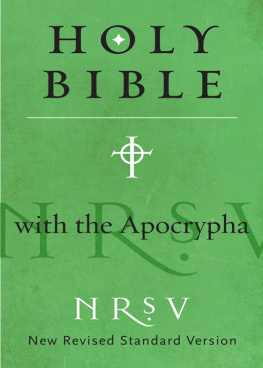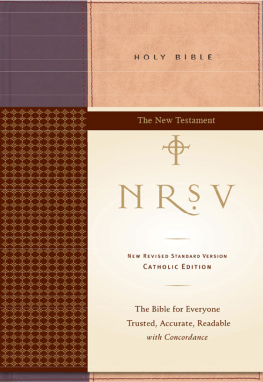NRSV Bible
NRSV Bible with the Apocrypha
NRSV Catholic Edition Bible
New American Bible
The Green Bible
The Green Bible - New Testament
The Green Bible - Old Testament
The Guidebook
The NRSV Daily Bible

The following abbreviations are used for the books of the Bible:
| Gen |
| Ex |
| Lev |
| Num |
| Deut |
| Josh |
| Judg |
| Ruth |
| 1 Sam |
| 2 Sam |
| 1 Kings |
| 2 Kings |
| 1 Chr |
| 2 Chr |
| Ezra |
| Neh |
| Esth |
| Job |
| Ps(s) |
| Prov |
| Eccl |
| Song |
| Isa |
| Jer |
| Lam |
| Ezek |
| Dan |
| Hos |
| Joel |
| Am |
| Ob |
| Jon |
| Mic |
| Nah |
| Hab |
| Zeph |
| Hag |
| Zech |
| Mal |
| Mt |
| Mk |
| Lk |
| Jn |
| Acts |
| Rom |
| 1 Cor |
| 2 Cor |
| Gal |
| Eph |
| Phil |
| Col |
| 1 Thess |
| 2 Thess |
| 1 Tim |
| 2 Tim |
| Titus |
| Philem |
| Heb |
| Jas |
| 1 Pet |
| 2 Pet |
| 1 Jn |
| 2 Jn |
| 3 Jn |
| Jude |
| Rev |
In the notes to the books of the Old Testament the following abbreviations are used:
| Ant. | Josephus, Antiquities of the Jews |
| Aram | Aramaic |
| Ch(s) | Chapter(s) |
| Cn | Correction; made where the text has suffered in transmission and the versions provide no satisfactory restoration, but where the Standard Bible Committee agrees with the judgment of competent scholars as to the most probable reconstruction of the original text. |
| Gk | Septuagint, Greek version of the OT |
| Heb | Hebrew of the consonantal Masoretic Text of the OT |
| Josephus | Flavius Josephus (Jewish historian, ca. 3795 CE ) |
| Macc. | The book(s) of the Maccabees |
| Ms(s) | Manuscript(s) |
| MT | The Hebrew of the pointed Masoretic Text of the OT |
| OL | Old Latin |
| Q Ms(s) | Manuscript(s) found at Qumran by the Dead Sea |
| Sam | Samaritan Hebrew text of the OT |
| Syr | Syriac Version of the OT |
| Syr H | Syriac Version of Origens Hexapla |
| Tg | Targum |
| Vg | Vulgate, Latin Version of the OT |
THIS PREFACE IS ADDRESSED TO YOU by the Committee of translators, who wish to explain, as briefly as possible, the origin and character of our work. The publication of our revision is yet another step in the long, continual process of making the Bible available in the form of the English language that is most widely current in our day. To summarize in a single sentence: the New Revised Standard Version of the Bible is an authorized revision of the Revised Standard Version, published in 1952, which was a revision of the American Standard Version, published in 1901, which, in turn, embodied earlier revisions of the King James Version, published in 1611.
In the course of time, the King James Version came to be regarded as the Authorized Version. With good reason it has been termed the noblest monument of English prose, and it has entered, as no other book has, into the making of the personal character and the public institutions of the English-speaking peoples. We owe to it an incalculable debt.
Yet the King James Version has serious defects. By the middle of the nineteenth century, the development of biblical studies and the discovery of many biblical manuscripts more ancient than those on which the King James Version was based made it apparent that these defects were so many as to call for revision. The task was begun, by authority of the Church of England, in 1870. The (British) Revised Version of the Bible was published in 188185; and the American Standard Version, its variant embodying the preferences of the American scholars associated with the work, was published, as was mentioned above, in 1901. In 1928 the copyright of the latter was acquired by the International Council of Religious Education and thus passed into the ownership of the churches of the United States and Canada that were associated in this council through their boards of education and publication.
The Council appointed a committee of scholars to have charge of the text of the American Standard Version and to undertake inquiry concerning the need for further revision. After studying the questions of whether revision should be undertaken and, if so, what its nature and extent should be, in 1937 the Council authorized a revision. The scholars who served as members of the Committee worked in two sections, one dealing with the OT and one with the NT . In 1946 the Revised Standard Version of the NT was published. The publication of the Revised Standard Version of the Bible, containing the OT and NT , took place on September 30, 1952. A translation of the Apocryphal/Deuterocanonical Books of the OT followed in 1957. In 1977 this collection was issued in an expanded edition containing three additional texts received by Eastern Orthodox communions (3 and 4 Maccabees and Psalm 151). Thereafter the Revised Standard Version gained the distinction of being officially authorized for use by all major Christian churches: Protestant, Anglican, Roman Catholic, and Eastern Orthodox.
The Revised Standard Version Bible Committee is a continuing body, comprising about thirty members, both men and women. Ecumenical in representation, it includes scholars affiliated with various Protestant denominations as well as several Roman Catholic members, an Eastern Orthodox member, and a Jewish member who serves in the OT section. For a period of time the Committee included several members from Canada and from England.
Because no translation of the Bible is perfect or acceptable to all groups of readers, and because discoveries of older manuscripts and further investigation of linguistic features of the text continue to become available, renderings of the Bible have proliferated. During the years following the publication of the Revised Standard Version, twenty-six other English translations and revisions of the Bible were produced by committees and by individual scholarsnot to mention twenty-five other translations and revisions of the NT alone. One of the latter was the second edition of the RSV NT , issued in 1971, twenty-five years after its initial publication.
Following the publication of the RSV OT in 1952, significant advances were made in the discovery and interpretation of documents in Semitic languages related to Hebrew. In addition to the information that had become available in the late 1940s from the Dead Sea texts of Isaiah and Habakkuk, subsequent acquisitions from the same area brought to light many other early copies of all the books of the Hebrew scriptures (except Esther), though most of these copies are fragmentary. During the same period early Greek manuscript copies of books of the NT also became available.
Next page
